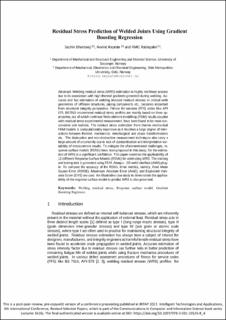Residual Stress Prediction Of Welded Joints Using Gradient Boosting Regression
Keprate, Arvind; Bhardwaj, Sachin; RATNAYAKE MUDIYANSELAGE, Chandima; Ratnayake Mudiyanselage, Chandima
Conference object
Accepted version
Permanent lenke
https://hdl.handle.net/11250/3023360Utgivelsesdato
2022-07-23Metadata
Vis full innførselSamlinger
Originalversjon
https://doi.org/10.1007/978-3-031-10525-8_4Sammendrag
Welding residual stress (WRS) estimation is highly nonlinear process due to its association with high thermal gradients generated during welding. Accurate and fast estimation of welding induced residual stresses in critical weld geometries of offshore structures, piping components etc., becomes important from structural integrity perspective. Fitness for services (FFS) codes like API 579, BS7910 recommend residual stress profiles are mainly based on three approaches, out of which nonlinear finite element modelling (FEM) results coupled with residual stress experimental measurement, have been found to be most conservative and realistic. The residual stress estimation from thermo mechanical FEM models is computationally expensive as it involves a large degree of interactions between thermal, mechanical, metallurgical and phase transformations etc. The destructive and non-destructive measurement techniques also carry a large amount of uncertainly due to lack of standardization and interpretation variability of measurement results. To mitigate the aforementioned challenges, response surface models (RSMs) have been proposed in this study, for the estimation of WRS at a significant confidence. This paper examines the applicability of 12 different Response Surface Models (RSMs) for estimating WRS. The training and testing data is generated using FEM, Abaqus- 2D weld interface (AWI) plugin. To compare the accuracy of the RSMs, three metrics, namely, Root Mean Square Error (RMSE), Maximum Absolute Error (AAE), and Explained Variance Score (EVS) are used. An illustrative case study to demonstrate the applicability of the response surface model to predict WRS is also presented.
